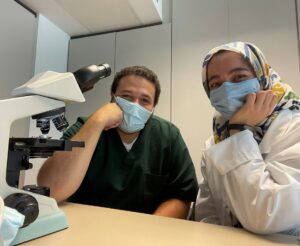If we want to learn something we should sink into it, like what I did with pathology.
Let’s start with the first step. Do you remember what is the first step? I am sure that you had followed my blogs, so, now you know what I mean about the first step. In the first step, we need to extract some significant features of our Whole Slide Images (WSIs). But how can we? In CLARIFY project we have discussed it and we gain that if we want to reach the best result, we should be aware of all important aspects of our project. According to this, we planned a secondment with one of the medical partners of our network. To due this, I had an awesome chance to spend one month in Instituto de Investigación Sanitaria (INCLIVA) to obtain more information about skin cancer, spitzoid, biopsies, cellular, and so on.
A question would cross in mind, why? Why would we need to know this medical information?
As we all know, for the first step we need to extract features from our dataset. But What is our dataset? What kind of features do we need? To deal with histopathology images, we need to be familiar with their features in deep, to recognize what would happen that tissue has cancer. Then, we extract what we need. Otherwise, how we can extract something that we don’t know!
To be honest, it was my first experience that I saw a biopsy. Let me share my exciting experience in INCLIVA.
IT IS A NEW WORLD.
During this month, every day I was counting the seconds for the moment that I could enter this amazing world with Prof. Carlos Monteagudo and our ESR12, Andres Mosquera. It is my pleaser that they gave me this opportunity to stop being blind in this field. Believe me, without knowing pathology, and the features of WSIs, you can extract features, but not as an intelligent person, as a blind person.
Here, I would like to conclude a short brief of an ocean of information that learned.
To have histopathology images for skin cancer, there are several necessary steps:
- A clinician examines a patient to understand whether he has cancer or not? If the probability of being cancerous reaches a critical point, they will ask for a tissue.
- A clinician would grab the tissue from the patient’s body.
- Some materials are necessary here to fix the tissue shape and texture.
- Clinicians would cut the cancerous tissue into some parts and put it in some cassettes.
- They will add some paraffin to it in a cold condition.
- Clinician is going to cut them in a proper thickness and prepare the first version of slides.
- Then the process of staining will start. Staining can be done with different materials. The most used is named Hematoxylin and Eosin (H&E). This can make our white tissue pink and purple. Pink and purple would be fat and cellular, respectively.
- NOW, the slides are ready for analysis.
- Pathologists by analyzing these tissues, according to the shape of cellular, Dermis, Epidermis, Dermo- Epidermal junction, basal layer, and a lot of features can understand whether the patient is lucky or he needs treatment.
- Meanwhile, they need more slides in deep to access more information about the tissue, such as the number of mitoses.
Here, I found an incredible application of a ruler that I have never thought about it.
- To calculate the depth of cancer they use a special ruler called eyepiece micrometer. In this case, the doctor and clinician can find the border of the cancerous tissue for other steps of treats.
- Pathologists write a note about their diagnosis for Clinician.
- Here, the process almost is done, otherwise, they need more tissue for analyzing more accurately. In this case, they ask for some more slides from deeper parts or new parts or even with different staining such as immunohistochemistry..
Since 31st July 2021, I am going to do my job with open eyes and I owe all these to Prof. Carlos Monteagudo and Andres. Thanks to them during this fascinating process, I learned a lot and now I know What am I going to extract from my dataset.
Zahra Tabatabei – ESR9.


